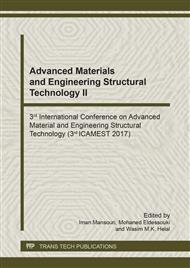p.80
p.85
p.90
p.95
p.100
p.106
p.112
p.117
p.123
Strain-Rate Dependence of Compressive Yield Strength of Titanium Grade 4 with Coarse-Grained and Ultrafine-Grained Structures: Experimental Results and Theoretical Calculation
Abstract:
The nanocrystalline (NC) and ultrafine-grained (UFG) structures of metallic materials can lead to their extraordinary high strength. However, most of the papers on this topic consider deformation parameters of NC and UFG materials only for the case of quasi-static tensile tests. Characteristics of dynamic strength and fracture of such materials remain unexplored. This paper presents a study of the mechanical behavior of pure titanium Grade 4 with a coarse-grained (CG) and UFG structure under uniaxial compression with different strain rates. The UFG structure was provided using the method of equal-channel angular pressing. The dynamic compression was carried out on a setup with the Split-Hopkinson pressure bar. It is found that in the observed range of strain rates 10–3-3×103 s–1, the yield stress of the CG titanium increases by 20%, and does not exceed the yield stress of the UFG titanium. However, the yield stress of the UFG titanium remains close to a quasi-static value. It is shown that these strain-rate dependencies of the yield strength can be predicted by the incubation time approach. The calculated curves show that at strain rates above 104 s–1 the yield stress of the CG titanium becomes higher than the yield strength of the UFG titanium.
Info:
Periodical:
Pages:
100-105
Citation:
Online since:
March 2018
Authors:
Price:
Сopyright:
© 2018 Trans Tech Publications Ltd. All Rights Reserved
Share:
Citation:


